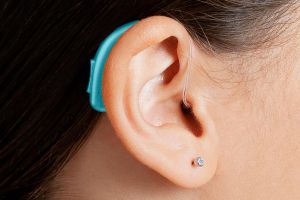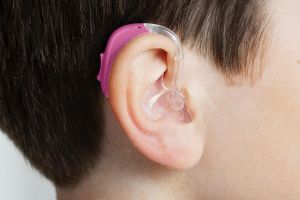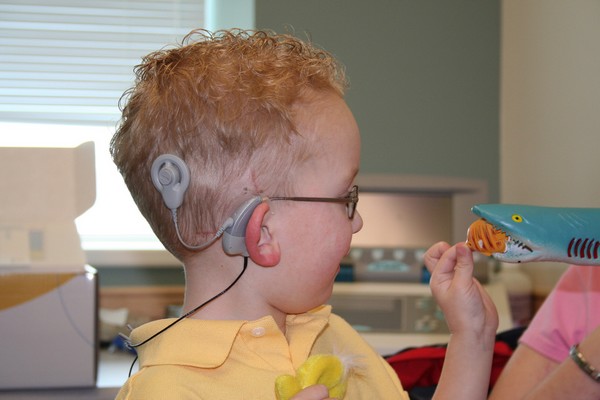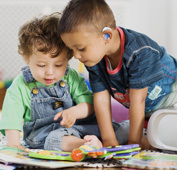For most families of children with hearing loss, the first important step toward hearing health will be having your infant or child fitted with hearing aids.

receiver-in-the-ear style.
Photo courtesy of Oticon.

Photo courtesy of Oticon.
At least two out of every 1,000 children screened for hearing loss in the U.S. are born deaf or with infant hearing loss that is caught through newborn hearing screening.
Other children will develop hearing loss later in childhood due to infection, medication side effects, a genetic condition or exposure to loud noises. If you suspect that your child has hearing loss, visit your pediatrician or ear, nose and throat (ENT) physician right away and ask for a referral to a pediatric audiologist. These hearing care professionals specialize in testing, treatment and follow-up for children with hearing loss.
Table of Contents
Pediatric hearing aids
All hearing aid models contain a microphone to pick up sound, a processor that analyzes the sound (filtering out unwanted sounds like excess wind noise, for example, while amplifying desired sounds), and a receiver (or speaker) to deliver the amplified sound deep inside the ear. A battery powers the unit, and it can be rechargeable or disposable. The latest models also connect to devices like smartphones, tablets and laptops to allow direct delivery of streamed sound through the hearing aid.
How pediatric hearing aids are different
Hearing aids made especially for infants and kids work very similarly to adult hearing aids, with a few key differences:
- Pediatric hearing aids are made to be more durable than adult models. Children can put a lot of wear and tear on hearing aids.
- Pediatric hearing aids are always compatible with FM systems and other assistive devices. For school-age kids, this is especially important to facilitate communication and learning.
- Battery cases on pediatric hearing aids are tamper-resistant. Batteries can be harmful if handled incorrectly or swallowed.
- Pediatric hearing aid cases often include a special LED light that indicates the unit is working. This feature allows parents and teachers quick checks of the devices.
Many pediatric hearing aids also are free of any possible allergens or harmful chemicals, and they come in many different bright colors. Depending on the child’s type and level of hearing loss, the size and style of the hearing aid may vary. Some children may wear a small unit behind their ear, with a thin tube and small plastic dome worn in the ear canal. Others may wear a slightly larger unit behind their ear (known as a “power” unit) and an earmold that fills the concha, or bowl, of the ear.
How young can kids wear hearing aids?
Hearing aids can be put on babies just a few months old. As they grow, children will need periodic hearing exams and new hearing aids, determined by your hearing care provider.
Importance of hearing aids for your child
If an audiologist recommends hearing aids for your child, it’s important that he or she wears them continuously, especially if the child is very young. Here’s why:
- From birth to three years, children’s brains are in a period of rapid development. Consistent sound input is critical for developing normal brain pathways for hearing, speech and language.
- Early listening and speaking are vital to language development. But when first learning a language, we can’t exactly “teach” it to children the way one would teach a school subject. Instead, language is caught. Children pick up on words and spoken syntax and language structure by being exposed to language continuously. For children with hearing loss, this incidental learning will need to be supplemented by speech and language therapy that focuses on attending to this auditory input.
- Consistent hearing is also important for children—especially infants and toddlers—in bonding with their parents. It builds trust and allows for the feeling of a predictable, reliable world.
Hearing aids can be especially helpful for children because their young brains are in a period of rapid development. Hearing well is vital to learning language, speech and literacy.
How do I know if my child needs a hearing aid or a cochlear implant?

hearing loss, but some need cochlear
implants.
Most children with hearing loss are able to benefit from hearing aids, though some will do better with a cochlear implant. The audiologist and other hearing health care professionals will determine whether your child is a candidate for hearing aids or cochlear implant based on the type and severity of the hearing loss, as well as the structure and shape of the outer ear.
As hearing loss is commonly identified in very young infants, children often start with hearing aids initially, and then become a candidate for a cochlear implant once they’re older. A child with hearing loss will have frequent hearing tests to carefully track hearing ability and hearing aid benefit.
For some kids, a type of hearing aid known as a bone-anchored hearing system may be the best option, particularly if they have single-sided deafness.
Hearing aid fitting
Almost all children are fit with behind-the-ear (BTE) hearing aids, regardless of the amount of hearing loss. There are small BTE sizes made specifically for children to ensure that the device will have a secure fit. The hearing aids deliver sound to the ear through a soft, plastic earmold that fits snugly in the outer ear, or a dome. Earmolds and domes can be easily replaced as the child grows bigger without the expense of replacing the actual hearing aids.
Below is an overview of the hearing aid fitting process for children.
Taking ear impressions and getting new earmolds
The first step of a hearing aid fitting is usually to take impressions of the outer ear canals. These must be taken to ensure that the earmolds for your child’s hearing aids fit perfectly. The hearing professional will place a cotton or foam dam deeply into the ear canal and then carefully fill the canal with impression material. To make sure all the ear structures are represented accurately, the impression material will fill the entire outer ear. The material takes a few minutes to set, so parents are often called on to hold the infant or child to keep inquisitive hands out of the way.

make wearing hearing
aids more fun for kids.
Earmolds can be ordered in a variety of colors; parents often choose a different color for each ear in order to make it easy to quickly determine which earmold fits which ear. As the child grows, new earmolds will be needed periodically and so colors can be changed up as desired. Older children often enjoy picking out the color. You can even choose a “clear” earmold. The audiologist will mail out the ear impressions and it will take up to two weeks to receive the custom earmolds order.
In the first five years of life, a child may need new earmolds every few weeks to months. Parents must learn to recognize the whistling sound that indicates hearing aid feedback—a sign that the earmolds aren’t fitting as well anymore and it’s time for a new one.
“Technology is the way sound gets in. It is the doorway to the brain. So we need to be sure technology is working well every minute,” said pediatric audiologist Jane Madell in an article on earmolds in babies. “If earmolds are not fitting well, sound will not reach the brain.”
Fitting the hearing aids
During this appointment, the audiologist will make sure the earmolds (or domes) fit your child’s ears properly and program the hearing aids for your child’s hearing loss. When the hearing aids are programmed and activated for the first time, your child will begin to hear new sounds right away. Infants tend to have an immediate reaction to mom or dad’s voice, turning their head with interest toward the parent who now makes sound. A toddler might smile in response to the new stimulation. After the initial programming and activation, the audiologist will do some verification tests to make sure that soft sounds are loud enough, average sounds are comfortable and loud sounds aren’t too loud.
The hearing professional will also spend a great deal of time teaching you how to place and remove the hearing aids, connect and disconnect the earmold or dome from the aid and how to tell the difference between the right and left aids. You will learn how to turn them on and off, how to do a listening check to make sure they’re functioning and how to replace or recharge the battery. You will also learn how to keep the hearing aids clean and how to store them each night.
Follow-up appointments
It will take time for your child to learn how to use the new sounds they perceive. Speech and language therapy will help the infant or child catch up to same-age peers and make sure milestones for speech, language and hearing are being met. Frequent follow-up appointments with the audiologist will be necessary to monitor hearing ability. If the child is fit as an infant, subsequent hearing tests will help quantify hearing ability across specific pitches. Behavioral hearing tests, the gold standard, will become easier to administer when the child is a toddler. Along the way, hearing aid programming will be modified to match these more specific hearing exam results.
A good working relationship with your child’s hearing care team is vital! Follow-up visits are important to monitor the hearing aids and your child’s progress with them.
The follow-up visits will also monitor the function and fit of the hearing instrument.
Hearing aid tips for parents
Keeping them on
It can be difficult to keep hearing aids on your child, especially toddlers and children who have not worn them consistently since infancy. If your child resists hearing aids or frequently pulls them off, there are some ways to make hearing aids more comfortable.
- Put the hearing aids on your child while you’re working on a fun activity together, during which he or she will be less interested in pulling them out or off.
- Try a soft headband that you can secure over the hearing aids, but make sure the microphone isn’t covered.
- Use special clips to keep the hearing aids attached to your child’s clothes. Even if the hearing aids are pulled off, you won’t lose the expensive devices.
Your audiologist can help you find headbands and clips that will work for your child.
If your child is reluctant to wear hearing aids, or new to wearing them, these children’s books about hearing loss may help them emotionally process the experience.
A hearing aid routine
Additionally, it’s a good idea to develop a routine each day for putting your infant or child’s hearing aids on. Spend time cuddling and holding your child when you put their hearing aids in to develop a positive association with them. When your curious child pulls the hearing aids off, be consistent but gentle in replacing them each time so he or she knows that’s where they belong.
If your child repeatedly pulls on the hearing aids or his or her ears, this might be a sign of discomfort from a poorly fitting earmold. See your child’s audiologist right away to find out if it’s time to get a new pair of earmolds or domes.
Daily checks
Children’s hearing aids need to be checked daily, especially for children who are too young to tell you if there is a problem. You’ll want to do a listening check, make sure the battery is working and check the hearing aids for debris and moisture. Remember, if you can’t hear sounds amplified through the hearing aids then your little one will not be able to hear through it, either.
You’ll also want to do a visual check before placing the hearing aids each time. Make sure the hearing aids and earmolds are clean and free of moisture. Disconnect the earmold from the hearing aid if it is dirty. Use a bulb syringe to blow any moisture out of the earmold or tubing and remove any debris from the earmold with a tissue or disinfectant wipe. When the earmold is thoroughly dry, connect it to the hearing aid again and place it back in your child’s ear.
Safety
For infants and children, choose hearing aids that have secure battery doors so they cannot get the hearing aid batteries out themselves. Babies like to put things in their mouths, so always store batteries safely out of reach of children and pets.
The right hearing aids can make a world of difference for your child’s social, educational and communication development. Work with your child’s audiologist, physician and educational support system to make the most of the experience.
Note: If your child has swallowed a hearing aid battery, seek emergency medical care right away. Time is of the essence. More on hearing aid battery safety.
Classroom help with hearing aids
Most hearing aid manufacturers who sell pediatric hearing aids and cochlear implants also make assistive listening devices to enhance classroom learning. One of the most popular option are FM systems. Typically, a teacher wears a microphone and the receiver is attached to the child’s hearing aid.

